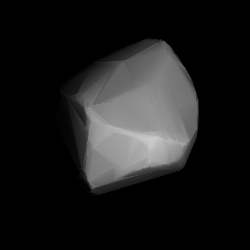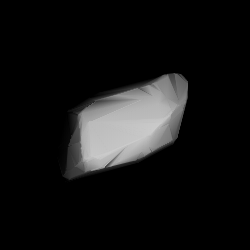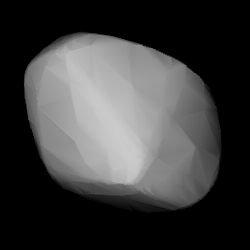
213 Lilaea is a large main belt asteroid. It was discovered by German-American astronomer C. H. F. Peters on February 16, 1880, in Clinton, New York and was named after Lilaea, a Naiad in Greek mythology.

236 Honoria is a large main belt asteroid that was discovered by Austrian astronomer Johann Palisa on 26 April 1884 in Vienna. The asteroid was named after Honoria, granddaughter of the Roman Emperor Theodosius I, who started negotiations with Attila the Hun. It is classified as a stony S-type asteroid based upon its spectrum. 236 Honoria is orbiting close to a 5:2 mean motion resonance with Jupiter, which is located at 2.824 AU.

237 Coelestina is a typical main belt asteroid.

244 Sita is a background asteroid from the inner region of the asteroid belt, approximately 11 kilometers in diameter. It was discovered on 14 October 1884, by an Austrian astronomer Johann Palisa in the Vienna Observatory. It was named for the Hindu deity Sita.

254 Augusta is a main-belt asteroid, discovered on 31 March 1886 by astronomer Johann Palisa at Vienna Observatory, Austria. The stony S-type asteroid measures about 12 kilometers in diameter. It is the first-numbered member of the Augusta family, after which the small Asteroid family and subgroup of the main-belt has been named. Augusta was named after the German–Austrian writer Auguste von Littrow (1819–1890), widow of astronomer Carl Ludwig von Littrow, who was a former director of the Vienna Observatory.

267 Tirza is a fairly sizeable, very dark Main belt asteroid.

296 Phaëtusa is a small Main belt asteroid. It was discovered by Auguste Charlois on 19 August 1890 in Nice.

301 Bavaria is a carbonaceous background asteroid from the intermediate asteroid belt, approximately 54 kilometers. It was discovered by Johann Palisa on 16 November 1890 in Vienna.

371 Bohemia is a sizeable Main belt asteroid. It was discovered by Auguste Charlois on 16 July 1893 in Nice.

384 Burdigala is a typical Main belt asteroid. It was discovered by F. Courty on 11 February 1894 in Bordeaux. It was the first of his two asteroid discoveries. The other was 387 Aquitania. Burdigala is the Latin name of the city of Bordeaux.
439 Ohio is a large Main belt asteroid.

440 Theodora is a small Main belt asteroid.
507 Laodica is a minor planet orbiting the Sun.

526 Jena is a Themistian asteroid. It was discovered in Heidelberg by the German astronomer Max Wolf on 14 March 1904 and named after the city of Jena.
593 Titania is a minor planet orbiting the Sun. The name may have been inspired by the asteroid's provisional designation 1906 TT.
625 Xenia is a minor planet orbiting the Sun. It was discovered by August Kopff in Heidelberg, Germany, on 11 February 1907. The name may have been inspired by the asteroid's provisional designation 1907 XN.
637 Chrysothemis is a Themistian asteroid.
646 Kastalia is a minor planet orbiting the Sun, not to be confused with the near-Earth asteroid 4769 Castalia.
668 Dora is an asteroid orbiting in the asteroid belt located roughly between the orbits of the planets Mars and Jupiter. The name may have been inspired by the asteroid's provisional designation 1908 DO.
823 Sisigambis is an asteroid belonging to the Flora family in the Main Belt. Its diameter is about 17 km and it has an albedo of 0.179. Its rotation period is unknown but appears to be greater than at least 12 hours. The asteroid is named after Sisygambis, the mother of Darius III of Persia.












